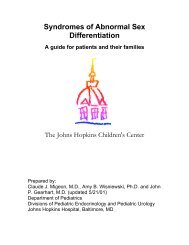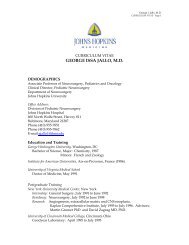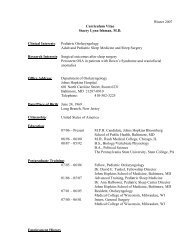Meals “at Your request” - Johns Hopkins Children's Center
Meals “at Your request” - Johns Hopkins Children's Center
Meals “at Your request” - Johns Hopkins Children's Center
Create successful ePaper yourself
Turn your PDF publications into a flip-book with our unique Google optimized e-Paper software.
n sept. 21, 2009, Bridget Diveley’s breathing suddenly<br />
became heavy, which prompted a quick visit to her<br />
pediatrician, then to the local ED, and finally to <strong>Johns</strong><br />
<strong>Hopkins</strong> Children’s <strong>Center</strong> where her parents heard<br />
the last thing they wanted to hear—their daughter<br />
might need a heart transplant. Debbie Long knew even<br />
before her daughter Emily’s birth that multiple cystic lesions<br />
had invaded her brain, a condition that would require repetitive surgeries<br />
throughout her life. Indeed, the now-18-year-old has undergone more than<br />
90 operations by renowned pediatric neurosurgeon Ben Carson. A surgical<br />
procedure shortly after birth delayed for six years the liver transplant Sam<br />
Tiemann would eventually need to live, but during that time he and his<br />
parents spent countless hours, days and weeks in the Children’s <strong>Center</strong>,<br />
which had become their second home.<br />
These parents, like many parents of pediatric<br />
patients at the Children’s <strong>Center</strong>,<br />
came in crisis, fought through turbulent<br />
times, returned time and again for followup<br />
treatment. They knew of <strong>Hopkins</strong> long<br />
history of success in treating complex, lifethreatening<br />
conditions, and they met physicians<br />
and nurses committed to providing<br />
the best possible outcome for their child.<br />
They felt they were in good hands—the<br />
best hands—and were grateful for the continuing<br />
care their child received.<br />
But for all the compassion and clinical<br />
expertise the hospital contained, the<br />
building itself—the Children’s Medical<br />
& Surgical <strong>Center</strong>, or CMSC—did little<br />
to lighten their emotional burden. The<br />
CMSC, a linear tissue-box of a building<br />
erected in the early 1960s, served practical<br />
clinical purposes quite well for almost<br />
a half-century. But over the years the brick<br />
and mortar began to lose its luster and<br />
imagination, freshness and uniqueness, its<br />
personality—aesthetic dynamics today’s<br />
hospital designers say create and sustain<br />
human connections and help heal. The<br />
clinical staff more than made up for any<br />
design deficits in the building, but both<br />
families and staff knew the Children’s<br />
<strong>Center</strong> could be much more with a new<br />
structure and style, which led to a new<br />
16 HOPKINS CHILDreN’S | hopkinschildrens.org<br />
building—The Charlotte R. Bloomberg<br />
Children’s <strong>Center</strong>—an artful design and a<br />
healing environment.<br />
“A growing body of evidence shows that<br />
you can create a hospital environment that<br />
connects with patients and families during<br />
a medical crisis, reduces their stress<br />
and anxiety, and enhances their health<br />
and wellbeing in a number of ways,” says<br />
Pediatrics Administrator Ted Chambers.<br />
“That’s what we set out to do through the<br />
art and design of this building.”<br />
One of the early goals was to make the<br />
new building approachable, but how do<br />
you do that with a structure twice the size<br />
of its predecessor? With, building designers<br />
decided, a curved façade covered by a<br />
Monet rainbow of paneled window boxes<br />
marked by countless brush strokes in the<br />
glass known as frit—the creation of installation<br />
artist Spencer Finch. The resulting<br />
effect is a translucent and shimmering<br />
curtain wall that constantly reflects and refracts<br />
the ever changing light of day.<br />
“From the beginning we were thinking<br />
about glass as an analog for water, how<br />
glass and water behave in similar ways, and<br />
what we could do with the glass so that<br />
it’s always changing,” says Finch. “Also,<br />
it’s a big building and it can be intimidating,<br />
but water has a certain softness and<br />
A growing body<br />
of evidence shows<br />
that you can<br />
create a hospital<br />
environment that<br />
connects with<br />
patients and<br />
families during<br />
a medical crisis,<br />
reduces their<br />
stress and anxiety,<br />
and enhances<br />
their health and<br />
wellbeing in a<br />
number of ways.<br />
– PeDIATrICS<br />
ADmINISTrATOr<br />
TeD CHAmBerS





